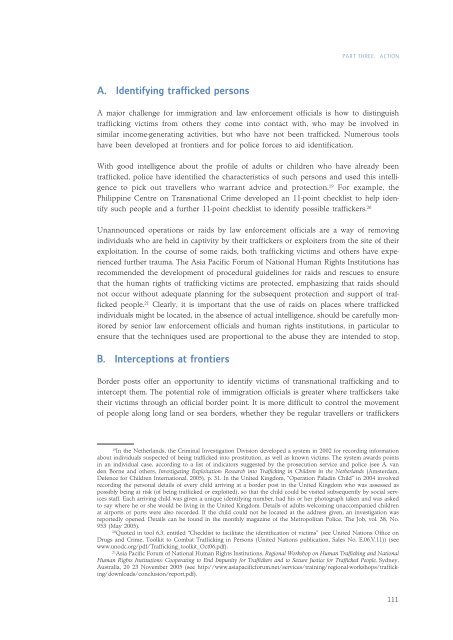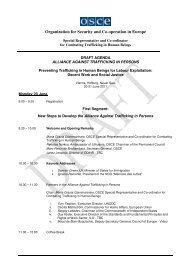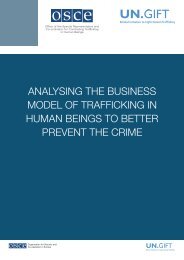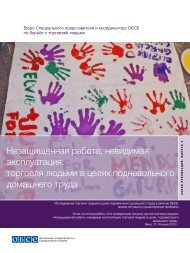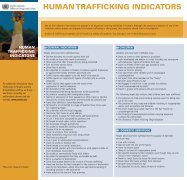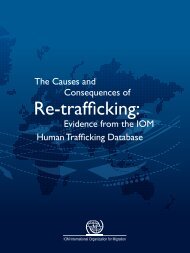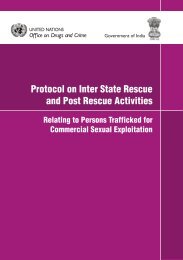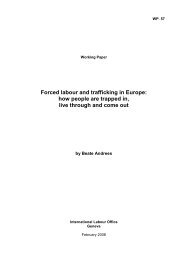An Introduction to Human Trafficking - United Nations Office on ...
An Introduction to Human Trafficking - United Nations Office on ...
An Introduction to Human Trafficking - United Nations Office on ...
You also want an ePaper? Increase the reach of your titles
YUMPU automatically turns print PDFs into web optimized ePapers that Google loves.
PART THREE.—ACTION<br />
A.—Identifying trafficked pers<strong>on</strong>s<br />
A major challenge for immigrati<strong>on</strong> and law enforcement officials is how <str<strong>on</strong>g>to</str<strong>on</strong>g> distinguish<br />
trafficking victims from others they come in<str<strong>on</strong>g>to</str<strong>on</strong>g> c<strong>on</strong>tact with, who may be involved in<br />
similar income-generating activities, but who have not been trafficked. Numerous <str<strong>on</strong>g>to</str<strong>on</strong>g>ols<br />
have been developed at fr<strong>on</strong>tiers and for police forces <str<strong>on</strong>g>to</str<strong>on</strong>g> aid identificati<strong>on</strong>.<br />
With good intelligence about the profile of adults or children who have already been<br />
trafficked, police have identified the characteristics of such pers<strong>on</strong>s and used this intelligence<br />
<str<strong>on</strong>g>to</str<strong>on</strong>g> pick out travellers who warrant advice and protecti<strong>on</strong>. 19 For example, the<br />
Philippine Centre <strong>on</strong> Transnati<strong>on</strong>al Crime developed an 11-point checklist <str<strong>on</strong>g>to</str<strong>on</strong>g> help identify<br />
such people and a further 11-point checklist <str<strong>on</strong>g>to</str<strong>on</strong>g> identify possible traffickers. 20<br />
Unannounced operati<strong>on</strong>s or raids by law enforcement officials are a way of removing<br />
individuals who are held in captivity by their traffickers or exploiters from the site of their<br />
exploitati<strong>on</strong>. In the course of some raids, both trafficking victims and others have experienced<br />
further trauma. The Asia Pacific Forum of Nati<strong>on</strong>al <str<strong>on</strong>g>Human</str<strong>on</strong>g> Rights Instituti<strong>on</strong>s has<br />
recommended the development of procedural guidelines for raids and rescues <str<strong>on</strong>g>to</str<strong>on</strong>g> ensure<br />
that the human rights of trafficking victims are protected, emphasizing that raids should<br />
not occur without adequate planning for the subsequent protecti<strong>on</strong> and support of trafficked<br />
people. 21 Clearly, it is important that the use of raids <strong>on</strong> places where trafficked<br />
individuals might be located, in the absence of actual intelligence, should be carefully m<strong>on</strong>i<str<strong>on</strong>g>to</str<strong>on</strong>g>red<br />
by senior law enforcement officials and human rights instituti<strong>on</strong>s, in particular <str<strong>on</strong>g>to</str<strong>on</strong>g><br />
ensure that the techniques used are proporti<strong>on</strong>al <str<strong>on</strong>g>to</str<strong>on</strong>g> the abuse they are intended <str<strong>on</strong>g>to</str<strong>on</strong>g> s<str<strong>on</strong>g>to</str<strong>on</strong>g>p.<br />
B.—Intercepti<strong>on</strong>s at fr<strong>on</strong>tiers<br />
Border posts offer an opportunity <str<strong>on</strong>g>to</str<strong>on</strong>g> identify victims of transnati<strong>on</strong>al trafficking and <str<strong>on</strong>g>to</str<strong>on</strong>g><br />
intercept them. The potential role of immigrati<strong>on</strong> officials is greater where traffickers take<br />
their victims through an official border point. It is more difficult <str<strong>on</strong>g>to</str<strong>on</strong>g> c<strong>on</strong>trol the movement<br />
of people al<strong>on</strong>g l<strong>on</strong>g land or sea borders, whether they be regular travellers or traffickers<br />
19<br />
In the Netherlands, the Criminal Investigati<strong>on</strong> Divisi<strong>on</strong> developed a system in 2002 for recording informati<strong>on</strong><br />
about individuals suspected of being trafficked in<str<strong>on</strong>g>to</str<strong>on</strong>g> prostituti<strong>on</strong>, as well as known victims. The system awards points<br />
in an individual case, according <str<strong>on</strong>g>to</str<strong>on</strong>g> a list of indica<str<strong>on</strong>g>to</str<strong>on</strong>g>rs suggested by the prosecuti<strong>on</strong> service and police (see A. van<br />
den Borne and others, Investigating Exploitati<strong>on</strong>: Research in<str<strong>on</strong>g>to</str<strong>on</strong>g> <str<strong>on</strong>g>Trafficking</str<strong>on</strong>g> in Children in the Netherlands (Amsterdam,<br />
Defence for Children Internati<strong>on</strong>al, 2005), p. 31. In the <str<strong>on</strong>g>United</str<strong>on</strong>g> Kingdom, “Operati<strong>on</strong> Paladin Child” in 2004 involved<br />
recording the pers<strong>on</strong>al details of every child arriving at a border post in the <str<strong>on</strong>g>United</str<strong>on</strong>g> Kingdom who was assessed as<br />
possibly being at risk (of being trafficked or exploited), so that the child could be visited subsequently by social services<br />
staff. Each arriving child was given a unique identifying number, had his or her pho<str<strong>on</strong>g>to</str<strong>on</strong>g>graph taken and was asked<br />
<str<strong>on</strong>g>to</str<strong>on</strong>g> say where he or she would be living in the <str<strong>on</strong>g>United</str<strong>on</strong>g> Kingdom. Details of adults welcoming unaccompanied children<br />
at airports or ports were also recorded. If the child could not be located at the address given, an investigati<strong>on</strong> was<br />
reportedly opened. Details can be found in the m<strong>on</strong>thly magazine of the Metropolitan Police, The Job, vol. 38, No.<br />
953 (May 2005).<br />
20<br />
Quoted in <str<strong>on</strong>g>to</str<strong>on</strong>g>ol 6.3, entitled “Checklist <str<strong>on</strong>g>to</str<strong>on</strong>g> facilitate the identificati<strong>on</strong> of victims” (see <str<strong>on</strong>g>United</str<strong>on</strong>g> <str<strong>on</strong>g>Nati<strong>on</strong>s</str<strong>on</strong>g> <str<strong>on</strong>g>Office</str<strong>on</strong>g> <strong>on</strong><br />
Drugs and Crime, Toolkit <str<strong>on</strong>g>to</str<strong>on</strong>g> Combat <str<strong>on</strong>g>Trafficking</str<strong>on</strong>g> in Pers<strong>on</strong>s (<str<strong>on</strong>g>United</str<strong>on</strong>g> <str<strong>on</strong>g>Nati<strong>on</strong>s</str<strong>on</strong>g> publicati<strong>on</strong>, Sales No. E.06.V.11)) (see<br />
www.unodc.org/pdf/<str<strong>on</strong>g>Trafficking</str<strong>on</strong>g>_<str<strong>on</strong>g>to</str<strong>on</strong>g>olkit_Oct06.pdf).<br />
21<br />
Asia Pacific Forum of Nati<strong>on</strong>al <str<strong>on</strong>g>Human</str<strong>on</strong>g> Rights Instituti<strong>on</strong>s, Regi<strong>on</strong>al Workshop <strong>on</strong> <str<strong>on</strong>g>Human</str<strong>on</strong>g> <str<strong>on</strong>g>Trafficking</str<strong>on</strong>g> and Nati<strong>on</strong>al<br />
<str<strong>on</strong>g>Human</str<strong>on</strong>g> Rights Instituti<strong>on</strong>s: Cooperating <str<strong>on</strong>g>to</str<strong>on</strong>g> End Impunity for Traffickers and <str<strong>on</strong>g>to</str<strong>on</strong>g> Secure Justice for Trafficked People, Sydney,<br />
Australia, 20 23 November 2005 (see http://www.asiapacificforum.net/services/training/regi<strong>on</strong>al-workshops/trafficking/downloads/c<strong>on</strong>clusi<strong>on</strong>/report.pdf).<br />
111


